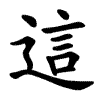這
| ||||||||
Translingual
| Stroke order | |||
|---|---|---|---|
 | |||
| Stroke order | |||
|---|---|---|---|
 | |||
Han character
這 (Kangxi radical 162, 辵+7, 10 strokes, cangjie input 卜卜一口 (YYMR), four-corner 30306, composition ⿺辶言)
Derived characters
- 𥳅 𬰊 𰫲 𰫎 𰧟 𤡖
References
- KangXi: page 1258, character 1
- Dai Kanwa Jiten: character 38889
- Dae Jaweon: page 1743, character 15
- Hanyu Da Zidian (first edition): volume 6, page 3844, character 5
- Unihan data for U+9019
Chinese
Glyph origin
Phono-semantic compound (形聲, OC *ŋrans) : semantic 辶 (“walk”) + phonetic 言 (OC *ŋan).
The character was originally a verb meaning “to meet”, whose modern pronunciation is yàn. It was later borrowed for the proximal demonstrative “this/here”, by a confusion in medieval handwriting with 遮 (zhē, “this”).
Etymology 1
| trad. | 這 | |
|---|---|---|
| simp. | 这 | |
| alternative forms | ||
First attested in the Tang Dynasty; etymology unclear. Proposed etymologies:
Pronunciation
Definitions
這
- this; these
- Synonym of 這樣/这样 (zhèyàng, “like this; such”).
- at this moment; right away; at once
- here
- Used before words for insults to add emphasis.
- filler particle usually used when the speaker is tongue-tied.
- meaningless particle in a sentence.
Synonyms
Antonyms
- 那 (nà, “that, those”)
Compounds
Etymology 2
| trad. | 這 | |
|---|---|---|
| simp. | 这 | |
Original meaning of this character. It is part of the 迎 (OC *ŋaŋ, *ŋraŋs, “to face, to meet”) word family; see there for more.
Pronunciation
Japanese
Readings
From Middle Chinese 這 (MC ŋˠiᴇnH, “to receive”):
- Go-on: げん (gen)
- Kan-on: げん (gen)
- Kun: むかえる (mukaeru, 這える)←むかへる (mukaferu, 這へる, historical); はう (hau, 這う)←はふ (fafu, 這ふ, historical)
Korean
Etymology 1
From Middle Chinese; compare Mandarin 這/这 (zhè).
Pronunciation
- (SK Standard/Seoul) IPA(key): [t͡ɕɘ(ː)]
- Phonetic hangul: [저(ː)]
- Though still prescribed in Standard Korean, most speakers in both Koreas no longer distinguish vowel length.
Usage notes
- The original meaning is "this". In certain words, it has been conflated with native Korean 저 (jeo, “that”).
Compounds
Etymology 2
From Middle Chinese 這 (MC ŋˠiᴇnH).
Pronunciation
- (SK Standard/Seoul) IPA(key): [ɘ(ː)n]
- Phonetic hangul: [언(ː)]
- Though still prescribed in Standard Korean, most speakers in both Koreas no longer distinguish vowel length.
Usage notes
- Used only in the reading of Classical Chinese; no Korean word appears to use this hanja.
Middle Korean
Glyph origin
Simplified from 邊 (“edge”), used as hungaja for similarly pronounced ᄀᆞᆺ〯 (kǒs, “edge”).
Usage notes
- Probably only found as reduplicated 這這, Idu spelling of the adverb 갓갓 (kàs-kàs, “of each kind”).